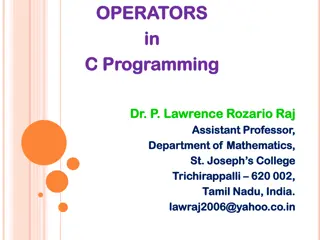Accelerating Lemma Learning Using Joins in Satisfiability Modulo Theories
Explore the use of joins in accelerating lemma learning within the context of Satisfiability Modulo Theories (SMT). The study covers various SMT applications at Microsoft and delves into the development of the Z3 solver. Key topics include theories, arithmetic operations, array theory, uninterpreted functions, and the application of lemma learning techniques. Discover how SMT solvers leverage theories, case-splitting, theory propagation, and conflict resolution to efficiently solve complex logical formulas.
Download Presentation

Please find below an Image/Link to download the presentation.
The content on the website is provided AS IS for your information and personal use only. It may not be sold, licensed, or shared on other websites without obtaining consent from the author.If you encounter any issues during the download, it is possible that the publisher has removed the file from their server.
You are allowed to download the files provided on this website for personal or commercial use, subject to the condition that they are used lawfully. All files are the property of their respective owners.
The content on the website is provided AS IS for your information and personal use only. It may not be sold, licensed, or shared on other websites without obtaining consent from the author.
E N D
Presentation Transcript
Accelerating lemma learning using joins LPAR 2008 Doha, Qatar Nikolaj Bj rner, Leonardo de Moura Microsoft Research Bruno Dutertre SRI International
Satisfiability Modulo Theories (SMT) SMT SAT Theories Arithmetic Bit-vectors Arrays Accelerating lemma learning using joins
Satisfiability Modulo Theories (SMT) + = = ) 1 + 2 ( ( ( , 3 , x ), ) 2 ( x y f read write a y f y x Arithmetic Accelerating lemma learning using joins
Satisfiability Modulo Theories (SMT) + = ) 2 = ) 1 + 2 ( ( ( , 3 , x ), ( x y f read write a y f y x Arithmetic Array Theory Accelerating lemma learning using joins
Satisfiability Modulo Theories (SMT) + = ) 2 = ) 1 + 2 ( ( ( , 3 , x ), ( x y f read write a y f y x Uninterpreted Arithmetic Array Theory Functions Accelerating lemma learning using joins
SMT: Some Applications @ Microsoft HAVOC Hyper-V Terminator T-2 VCC Vigilante NModel F7 SAGE Accelerating lemma learning using joins
SMT@Microsoft: Solver Z3 is a new solver developed at Microsoft Research. Development/Research driven by internal customers. Free for academic research. Interfaces: C/C++ .NET Text OCaml Z3 http://research.microsoft.com/projects/z3 Accelerating lemma learning using joins
SMT = DPLL + Theories a=b f(a)=f(b), a < 5 a > 10, a > 6 b = 2 Guessing (case-splitting) Deducing (BCP + Theory propagation) Conflict resolution Backtracking + Lemma Most SMT solvers use only the literals from the given formula! Accelerating lemma learning using joins
Is SMT fast??? a[0] = 0 if (c1) { a[1] = 0; } else { a[1] = 1; } if (cn) { a[n] = 0; } else { a[n] = 1; } assert(a[0] == 0); Accelerating lemma learning using joins
Is SMT fast??? a1= write(a0, 0, 0) ( c1 a2 = write(a1,1,0)) (c1 a2 = write(a1,1,1)) ( cn an+1 = write(an,n,0)) (cn an+1 = write(an,n,1)) read(an+1,0) 0 It takes O(2n) time if lemmas do not use new literals! Accelerating lemma learning using joins
Diamonds are eternal Accelerating lemma learning using joins
SP(E) calculus It can solve diamonds in polynomial time. Very slow in practice! Accelerating lemma learning using joins
DPLL (E + ) New literals can be created Case-splitting (guessing) Lemma Learning Any SP(E) inference can be simulated by DPLL(E+ ) Accelerating lemma learning using joins
How do we create ? Accelerating lemma learning using joins
Look ahead New literal p ll S p ll Accelerating lemma learning using joins
Look ahead S S, ll Accelerating lemma learning using joins
The plan Define language L (of new literals). Examples: (Bounds) x > 5 (Equality) x = y (Difference) x y < 3 Theory propagation for L Join operator for L p S1 S S1 S2 S2 p Accelerating lemma learning using joins
Join: Examples (Bounds) p q, q x>5, p x>y, y > 4 Accelerating lemma learning using joins
Join: Examples (Bounds) p q, q x>5, p x>y, y > 4 p { x > 5 } Accelerating lemma learning using joins
Join: Examples (Bounds) p q, q x>5, p x>y, y > 4 p p { x > 5 } { x > 4 } Accelerating lemma learning using joins
Join: Examples (Bounds) p q, q x>5, p x>y, y > 4 p p { x > 5 } { x > 4 } { x > 5 } { x > 4 } = {x > 4} Accelerating lemma learning using joins
Join: Examples (Equalities) { x = y, y = z, x = z } { x = z, z = w, x = w } = {x = z} Accelerating lemma learning using joins
Join: Examples (Difference constraints) { x - y < 3 } { x - y < 2, y - z < 1, x - z < 3} = {x - y < 3} Accelerating lemma learning using joins
Join Other examples: Linear arithmetic: polyhedral. Array partial equalities: a =i b (forall x: x = i a[x] = b[x]) k-look ahead. Accelerating lemma learning using joins
Conclusion SMT solvers are fast, but they may choke in simple formulas. DPLL(join) = SMT + Abstract Interpretation . Future work: new literals during conflict resolution. http://research.microsoft.com/projects/z3 Thank You! Accelerating lemma learning using joins























